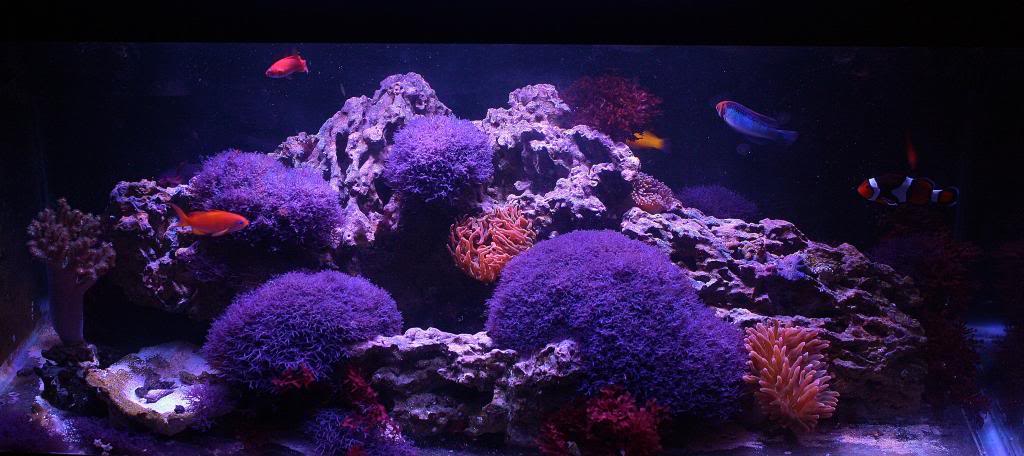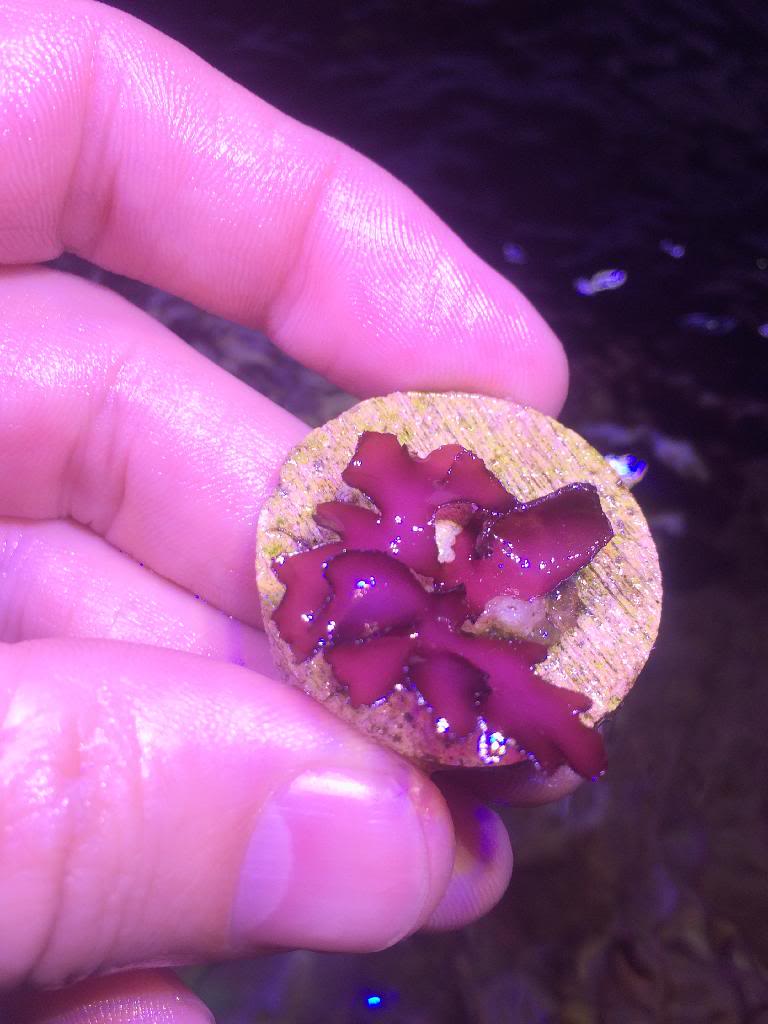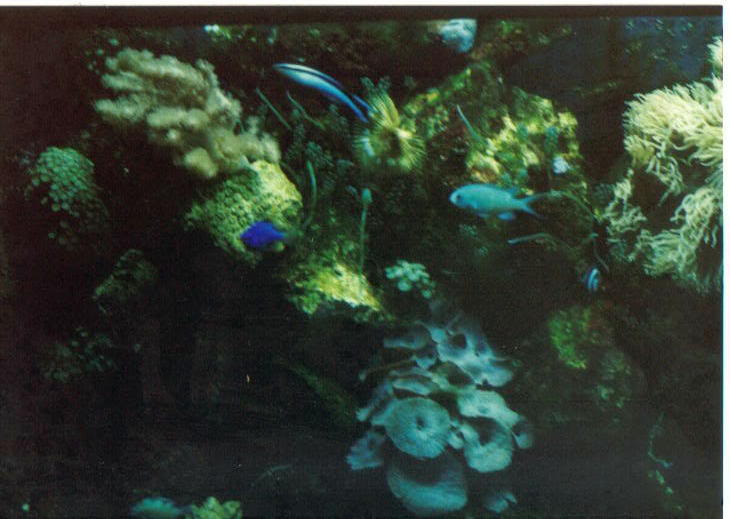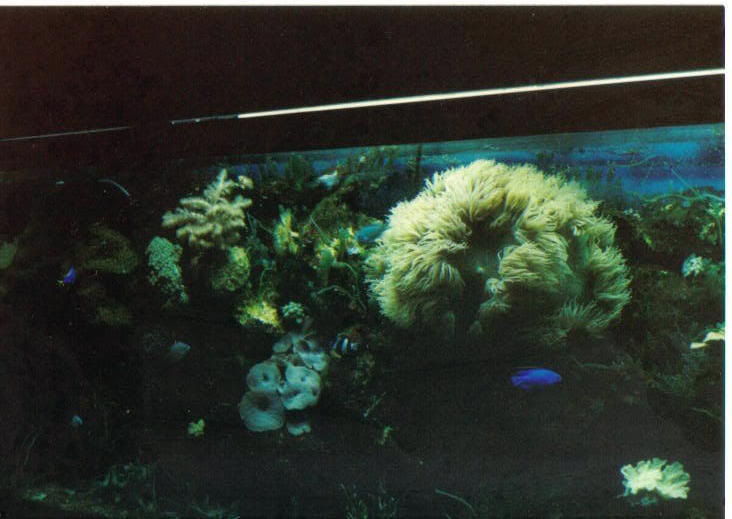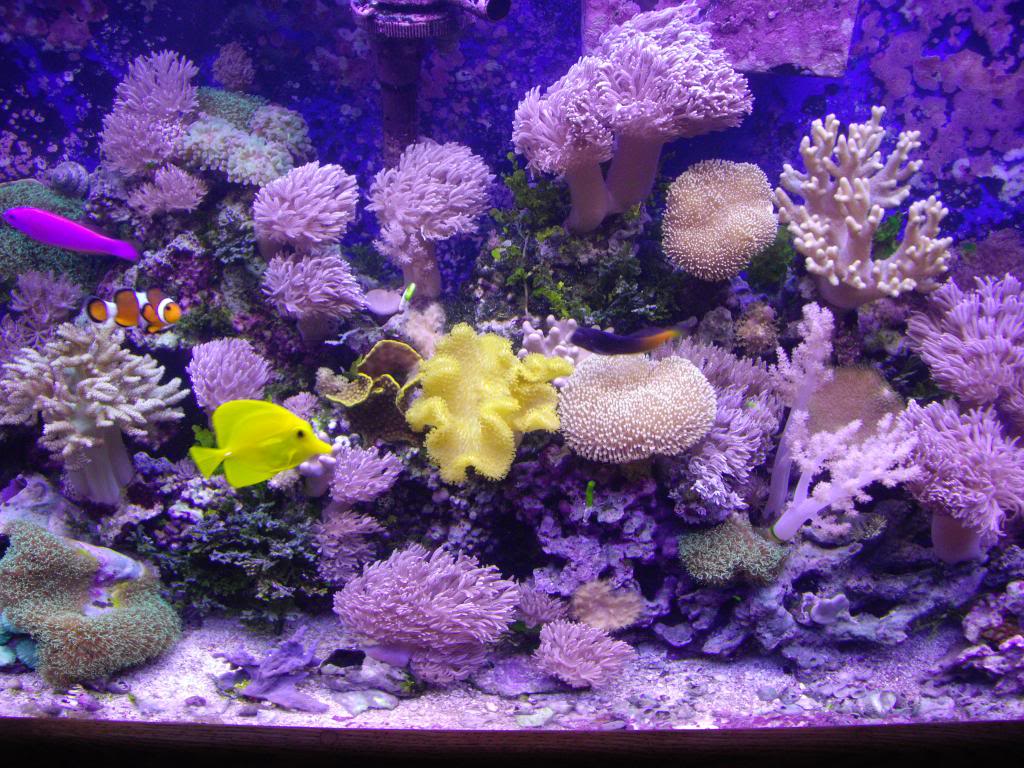If you're a long-time reefer- and I mean L-O-O-N-G time, like from the late eighties- you'll remember when a typical reef aquarium had fishes, some basic corals (Woah! That's a Bubble Coral, isn't it? Crazy! Who did you have to bribe to get THAT?), and macro algae. Yeah, that's right; you'd see the typical Dutch reef systems with some corals, but loaded with macro algae, such as Caulerpa, Ochtodes, Halymenia, Dictyota, Padina, Penicillus, and Halimeda. Macroalgae were as much a part of a reef aquarium as any coral. In fact, if you didn't have some form of macro algae in your system, you were looked at rather oddly!
As the years crept by, and more emphasis was placed on corals in the display, macro algae were relegated to a support role- primarily a utilitarian nutrient export role in refugua and lighted sumps across the reef-keeping world. Gradually, they have more-or-less faded into a niche, much as NPS corals, fish breeding, and soft coral tanks have. Nothing at all wrong with that, but it is kind of interesting to me. Sure, we've all heard the issues associated with Caulerpa, such as its propensity to overrun corals, release its gametes into the water and crash, causing serious stress on the closed reef. However, there are a whole host of macro algae and seagrasses that are perfectly interesting, attractive, and enjoyable to keep.
Macroalgae add another dimension, both aesthetically and functionally, to the reef display itself. The same can be said for seagrasses, which we'll talk about in just a bit. There are literally dozens of macro algae that can be incorporated into our reef tanks, and to even attempt to cover any appreciable number of them in this brief piece would be folly on my part. I'll give you a rundown on a few that I think are both cool and commonly encountered, but you'll want to check out more on your own, and maybe visit the specialized forums that are dedicated just to macroalage and marine plants.
It seems like the current nutrient export vehicle of choice is Chaetomorpha. And rightfully so- the stuff grows very quickly, is well behaved, doesn't crash, and is easily harvested to help facilitate permanent nutrient export from your system. Granted, it's morphology and habits make it an unattractive choice for keeping in the display, but it's still pretty cool stuff.
One of my other faves is Botrycladia, a red macro algae that looks a lot like our old nemesis, Caulerpa racemosa. It's even called the Sea Grape in some quarters. Unlike the Caulerpa, however, this stuff is perfectly well behaved, anchors to rocks, and won't smother your prized Acan collection (unless you allow it to!). And, as an added plus, it's pretty easy to propagate by simply breaking off a section and securing to to rock work or other substrate. It's color is an awesome contrast to many other algae and corals.

Botrycladia is a cool way to add some color to your reef tank!
I'm also a big fan of Halymenia, a beautiful macro algae also known as Dragon's Breath (Funny, I knew a guy in my fraternity days that we gave the same nickname to..). It's a graceful and very attractive species that easily attaches to rocks and grows quite quickly if conditions are to its liking. It's one that I've seen in the ocean before a number of times, and it's as pretty in nature as it can be in your aquarium!
So I touched on three lousy species of like dozens that you can try. The point is, you can really create some cool displays with just macroalgae. And, it's an excuse for another tank, right? Dang, I'm on a role, helping reefers AND the economy! And to think, I'm getting dissed by MACNA this year..pffft!

Does this not inspire you to set up a macro algae tank? A dive shot off of Belize- macro algae galore...and Grammas!
As a traveling fish geek, I'm lucky enough to talk to lots of hobbyists on a monthly basis. It's a good life, with good times (If this is Saturday, I must be in Akron, right? Or was it Detroit?). I see a lot of cool aquariums and neat people. I see aquariums chock full of SPS corals, rare zoanthids, unusual fishes, etc. Some aquariums feature amazing aquascaping or ingenious plumbing systems. I see home based coral propagation systems and the occasional basement fish breeding operation. I've even seen an occasional sprig or two of macroalgae! Rarely, however, do I encounter aquariums dedicated to-or at least featuring-seagrasses. That's right- seagrasses!
Okay, we all have probably seen or heard about them at one time or another, but rarely do we find ourselves actually playing with them! They are not at all rare in the wild- In fact, they are found all over the world, and there are more than 60 species known to science. Seagrass beds provide amazing benefits to coral reef ecosystems, such as protection from sedimentation, a nursery for larval fishes, and a feeding ground for many adult fishes.. In the aquarium, they can perform many of the same functions. So why are we not seeing more of them in the hobby?
I believe there are three main reasons why we don't: 1) They suffer from what I call the Caulerpa Syndrome- a bad rep ascribed to just about anything green in the marine hobby- They will smother your corals, or They can crash and kill everything in the tank, or even, They give off toxic byproducts that inhibit coral growth. 2) There simply aren't enough people working with them to get them out to the hobby in marketable quantities. 3) They are finicky and hard to grow.

A seagrass and macroalgae tank..every bit a "reef" system, IMHO
Let's beat up* Number 1 first: Seagrasses are true vascular plants, not macroalgae, and they do not creep over rocks, go sexual and crash, or exude chemicals that will stifle the growth of your True Echinata! In fact, they are mild-mannered, grow at a relatively modest rate, and are compatible with just about everything we keep in a reef tank. And no, they will not smother your corals or grow over rockwork. They grow in soils and sandbeds, and need to put down root systems. You can keep them nicely confined to just the places that you want them. Dedicate a section of sandbed that you'd like them to grow, plant them, give them good conditions, and you'll be a fan in no time!
Reason Number 2 is probably caused in part by #1, but in actuality, is the most probable reason why we don't see them everywhere: Until very recently, they were the sole domain of dedicated specialty hobbyists, who delighted in growing plants and taking on other challenges. The hobby as a whole simply never sees them in quantity, helping spur the (false) image that they are rare, dangerous, or difficult to work with. Quite frankly, they are really hard to find commercially. Someone (hey- that can be YOU) needs to step up and produce/distribute them in quantity! It will require some dedication and patience, but could be a cool payoff.
Reason Number 3 has a bit of truth to it. Some of the seagrasses can be a bit finicky at first, and don't always take initially when transplanted. Like any plant, they go through an adjustment period, after which they will begin to grow and thrive if conditions are to their liking. It has also been discovered in recent years that there are microbial associations in the soils/sediments that they are found in which enable them to settle in better and adapt to new conditions. So in short, if you are obtaining seagrasses, you can never hurt your cause if they come with some of the substrate that they grew in.
If you can provide a mature, rich sand bed (say 3"-6"), good quality lighting (daylight spectrum or 10k work well), decent water quality, and no large populations of harsh herbivorous fishes, like some Tangs or Rabbitfishes), you can almost guarantee some success. And the other key ingredient is patience. You need to leave them alone, let them acclimate, and allow them to grow on their own.
By the way, you can use a variety of commercially-available substrate materials in addition to your fish-waste-filled sand, such as products made by Kent Marine, Seachem and Carib Sea, that are designed just for this purpose! How ironic- products exist to help grow seagrasses, and so few people are actually taking advantage of them! They're usually used for refugium substrates.
There are three main species that we might encounter in the hobby: Halodule, or Shoal Grass, Halophilia , knows as Stargrass, Paddle Grass, or Oar Grass, and Thalassia, known commonly as Turtle Grass. I call them The Big Three. Each one has slightly different requirements, and I will briefly cover them here.
Halodule looks a lot like the freshwater plant Sagittaria, or Micro Sword, in my opinion- and grows like it, too. Plant it in a modestly deep (3"), rich substrate, and it will put down a dense system of runners as it establishes itself. Once it establishes itself, it's about as easy to grow as an aquatic plant can be, IMO. I think it's the best candidate for extensive captive propagation, so those of you with greenhouses or propagation systems should devote a tray or two to this stuff. I envision this being grown in pony packs like you see with groundcover plants at your local nursery, so that a hobbyists can purchase a flat of Halodule and simply plop it into their tank.. Think of the commercial possibilities here, folks!
Halophila is a very attractive plant, which, although slightly more delicate and challenging than Halodule, is still relatively easy to grow, and is really pretty, too! I've grown this plant in substrates as shallow as 2.5", but you probably want 3" or more for good solid growth. This seagrass definitely shocks out when you transplant it, and you will lose some leaves straight away. However, with patience, good conditions, and a little time, it will come back into its own and form a beautiful addition to your reef tank. Oh, and it flowers! Seriously! And man, it would be a nice sight to see at your next club frag swap- I'll bet you could get a choice Krakatoa Paly in trade for a few Halophila!

...and it Flowers!
Thalassia is THE seagrass to most people- the one we envision when we hear the term Seagrass. It's called Turtle Grass, and it is one of the larger varieties, growing up to 24" in height if space permits. Its thick leaves create a beautiful contrast to rockwork, and it can create an interesting area for fishes to forage when you can get a thick growth of it. It does grow VERY slowly, and you will typically have to start with a quite a few plants if you are trying to fill in a designated space in your tank. It requires a pretty deep sand bed, too- 5 to 6 inches or more is ideal. Because of it's slow growth rate and height requirements, it's the least attractive candidate for captive propagation, IMO. However, it is still a lovely plant with much to offer.

Thalassia is definitely the "official seagrass of the reef hobby."
Seagrasses and macro algae offer just another interesting diversion and an opportunity for you to try something altogether new. Not only will you be growing something cool and exciting, you'll have a chance to get in on the ground floor of a new area of the marine hobby if you pursue seagrasses. By unlocking the secrets of seagrasses, you will be further contributing to the body of knowledge of the husbandry of these plants. Obviously, I just scratched the uppermost surface of the topic here, but I'm hopeful that I have piqued your interest enough to give the seagrasses a try!
Don't hate on the macroalgae, either. I mean, a good macro is at least as interesting as ANY morph of Montipora capricornus, right (Man, I just keep hating on the Monti Caps, don't I?)? There are some beautiful macro algae-dominant tanks out there! I mean, we can go on and on talking about this stuff..
If you've got a love for macros and seagrasses, let's see some pics!
Stay Green (and red and brown)..And above all,
Stay Wet.
Scott Fellman
Unique Corals





As the years crept by, and more emphasis was placed on corals in the display, macro algae were relegated to a support role- primarily a utilitarian nutrient export role in refugua and lighted sumps across the reef-keeping world. Gradually, they have more-or-less faded into a niche, much as NPS corals, fish breeding, and soft coral tanks have. Nothing at all wrong with that, but it is kind of interesting to me. Sure, we've all heard the issues associated with Caulerpa, such as its propensity to overrun corals, release its gametes into the water and crash, causing serious stress on the closed reef. However, there are a whole host of macro algae and seagrasses that are perfectly interesting, attractive, and enjoyable to keep.
Macroalgae add another dimension, both aesthetically and functionally, to the reef display itself. The same can be said for seagrasses, which we'll talk about in just a bit. There are literally dozens of macro algae that can be incorporated into our reef tanks, and to even attempt to cover any appreciable number of them in this brief piece would be folly on my part. I'll give you a rundown on a few that I think are both cool and commonly encountered, but you'll want to check out more on your own, and maybe visit the specialized forums that are dedicated just to macroalage and marine plants.
It seems like the current nutrient export vehicle of choice is Chaetomorpha. And rightfully so- the stuff grows very quickly, is well behaved, doesn't crash, and is easily harvested to help facilitate permanent nutrient export from your system. Granted, it's morphology and habits make it an unattractive choice for keeping in the display, but it's still pretty cool stuff.
One of my other faves is Botrycladia, a red macro algae that looks a lot like our old nemesis, Caulerpa racemosa. It's even called the Sea Grape in some quarters. Unlike the Caulerpa, however, this stuff is perfectly well behaved, anchors to rocks, and won't smother your prized Acan collection (unless you allow it to!). And, as an added plus, it's pretty easy to propagate by simply breaking off a section and securing to to rock work or other substrate. It's color is an awesome contrast to many other algae and corals.
Botrycladia is a cool way to add some color to your reef tank!
I'm also a big fan of Halymenia, a beautiful macro algae also known as Dragon's Breath (Funny, I knew a guy in my fraternity days that we gave the same nickname to..). It's a graceful and very attractive species that easily attaches to rocks and grows quite quickly if conditions are to its liking. It's one that I've seen in the ocean before a number of times, and it's as pretty in nature as it can be in your aquarium!
So I touched on three lousy species of like dozens that you can try. The point is, you can really create some cool displays with just macroalgae. And, it's an excuse for another tank, right? Dang, I'm on a role, helping reefers AND the economy! And to think, I'm getting dissed by MACNA this year..pffft!
Does this not inspire you to set up a macro algae tank? A dive shot off of Belize- macro algae galore...and Grammas!
As a traveling fish geek, I'm lucky enough to talk to lots of hobbyists on a monthly basis. It's a good life, with good times (If this is Saturday, I must be in Akron, right? Or was it Detroit?). I see a lot of cool aquariums and neat people. I see aquariums chock full of SPS corals, rare zoanthids, unusual fishes, etc. Some aquariums feature amazing aquascaping or ingenious plumbing systems. I see home based coral propagation systems and the occasional basement fish breeding operation. I've even seen an occasional sprig or two of macroalgae! Rarely, however, do I encounter aquariums dedicated to-or at least featuring-seagrasses. That's right- seagrasses!
Okay, we all have probably seen or heard about them at one time or another, but rarely do we find ourselves actually playing with them! They are not at all rare in the wild- In fact, they are found all over the world, and there are more than 60 species known to science. Seagrass beds provide amazing benefits to coral reef ecosystems, such as protection from sedimentation, a nursery for larval fishes, and a feeding ground for many adult fishes.. In the aquarium, they can perform many of the same functions. So why are we not seeing more of them in the hobby?
I believe there are three main reasons why we don't: 1) They suffer from what I call the Caulerpa Syndrome- a bad rep ascribed to just about anything green in the marine hobby- They will smother your corals, or They can crash and kill everything in the tank, or even, They give off toxic byproducts that inhibit coral growth. 2) There simply aren't enough people working with them to get them out to the hobby in marketable quantities. 3) They are finicky and hard to grow.
A seagrass and macroalgae tank..every bit a "reef" system, IMHO
Let's beat up* Number 1 first: Seagrasses are true vascular plants, not macroalgae, and they do not creep over rocks, go sexual and crash, or exude chemicals that will stifle the growth of your True Echinata! In fact, they are mild-mannered, grow at a relatively modest rate, and are compatible with just about everything we keep in a reef tank. And no, they will not smother your corals or grow over rockwork. They grow in soils and sandbeds, and need to put down root systems. You can keep them nicely confined to just the places that you want them. Dedicate a section of sandbed that you'd like them to grow, plant them, give them good conditions, and you'll be a fan in no time!
Reason Number 2 is probably caused in part by #1, but in actuality, is the most probable reason why we don't see them everywhere: Until very recently, they were the sole domain of dedicated specialty hobbyists, who delighted in growing plants and taking on other challenges. The hobby as a whole simply never sees them in quantity, helping spur the (false) image that they are rare, dangerous, or difficult to work with. Quite frankly, they are really hard to find commercially. Someone (hey- that can be YOU) needs to step up and produce/distribute them in quantity! It will require some dedication and patience, but could be a cool payoff.
Reason Number 3 has a bit of truth to it. Some of the seagrasses can be a bit finicky at first, and don't always take initially when transplanted. Like any plant, they go through an adjustment period, after which they will begin to grow and thrive if conditions are to their liking. It has also been discovered in recent years that there are microbial associations in the soils/sediments that they are found in which enable them to settle in better and adapt to new conditions. So in short, if you are obtaining seagrasses, you can never hurt your cause if they come with some of the substrate that they grew in.
If you can provide a mature, rich sand bed (say 3"-6"), good quality lighting (daylight spectrum or 10k work well), decent water quality, and no large populations of harsh herbivorous fishes, like some Tangs or Rabbitfishes), you can almost guarantee some success. And the other key ingredient is patience. You need to leave them alone, let them acclimate, and allow them to grow on their own.
By the way, you can use a variety of commercially-available substrate materials in addition to your fish-waste-filled sand, such as products made by Kent Marine, Seachem and Carib Sea, that are designed just for this purpose! How ironic- products exist to help grow seagrasses, and so few people are actually taking advantage of them! They're usually used for refugium substrates.
There are three main species that we might encounter in the hobby: Halodule, or Shoal Grass, Halophilia , knows as Stargrass, Paddle Grass, or Oar Grass, and Thalassia, known commonly as Turtle Grass. I call them The Big Three. Each one has slightly different requirements, and I will briefly cover them here.
Halodule looks a lot like the freshwater plant Sagittaria, or Micro Sword, in my opinion- and grows like it, too. Plant it in a modestly deep (3"), rich substrate, and it will put down a dense system of runners as it establishes itself. Once it establishes itself, it's about as easy to grow as an aquatic plant can be, IMO. I think it's the best candidate for extensive captive propagation, so those of you with greenhouses or propagation systems should devote a tray or two to this stuff. I envision this being grown in pony packs like you see with groundcover plants at your local nursery, so that a hobbyists can purchase a flat of Halodule and simply plop it into their tank.. Think of the commercial possibilities here, folks!
Halophila is a very attractive plant, which, although slightly more delicate and challenging than Halodule, is still relatively easy to grow, and is really pretty, too! I've grown this plant in substrates as shallow as 2.5", but you probably want 3" or more for good solid growth. This seagrass definitely shocks out when you transplant it, and you will lose some leaves straight away. However, with patience, good conditions, and a little time, it will come back into its own and form a beautiful addition to your reef tank. Oh, and it flowers! Seriously! And man, it would be a nice sight to see at your next club frag swap- I'll bet you could get a choice Krakatoa Paly in trade for a few Halophila!
...and it Flowers!
Thalassia is THE seagrass to most people- the one we envision when we hear the term Seagrass. It's called Turtle Grass, and it is one of the larger varieties, growing up to 24" in height if space permits. Its thick leaves create a beautiful contrast to rockwork, and it can create an interesting area for fishes to forage when you can get a thick growth of it. It does grow VERY slowly, and you will typically have to start with a quite a few plants if you are trying to fill in a designated space in your tank. It requires a pretty deep sand bed, too- 5 to 6 inches or more is ideal. Because of it's slow growth rate and height requirements, it's the least attractive candidate for captive propagation, IMO. However, it is still a lovely plant with much to offer.
Thalassia is definitely the "official seagrass of the reef hobby."
Seagrasses and macro algae offer just another interesting diversion and an opportunity for you to try something altogether new. Not only will you be growing something cool and exciting, you'll have a chance to get in on the ground floor of a new area of the marine hobby if you pursue seagrasses. By unlocking the secrets of seagrasses, you will be further contributing to the body of knowledge of the husbandry of these plants. Obviously, I just scratched the uppermost surface of the topic here, but I'm hopeful that I have piqued your interest enough to give the seagrasses a try!
Don't hate on the macroalgae, either. I mean, a good macro is at least as interesting as ANY morph of Montipora capricornus, right (Man, I just keep hating on the Monti Caps, don't I?)? There are some beautiful macro algae-dominant tanks out there! I mean, we can go on and on talking about this stuff..
If you've got a love for macros and seagrasses, let's see some pics!
Stay Green (and red and brown)..And above all,
Stay Wet.
Scott Fellman
Unique Corals


